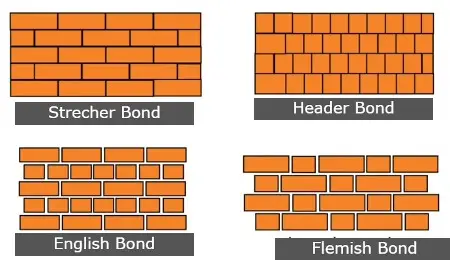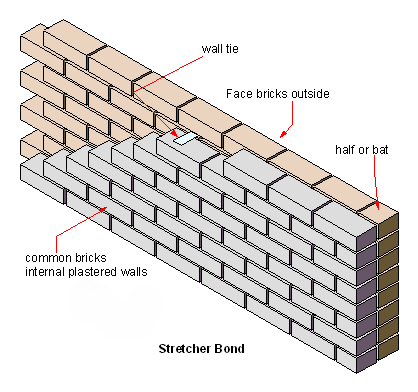The consistent pattern of brickwork that maximizes the strength of the building is called “brick bonding” in the construction sector. Although the brick bond’s main function is structural, it may also significantly impact your home’s exterior look and your home’s distinctive style. Hence, in this blog, Brick & Bolt explains what a brick bond is and the top 11 types of brick bonds used in masonry.
What is a Brick Bond?
A brick bond is a pattern that is used to place bricks within the building they make, such as a sidewalk, wall, or column. They may be arranged widthwise, horizontally, or standing upright. Simply put, the way bricks are put is called a brick bond. It works for things like brick walls, brick flooring or paving for yards and paths.
There are numerous types of brick bonds, and each has unique characteristics, installation difficulties, and structural issues when it comes to wall construction.
11 Types of bond in brick masonry
The following are the types of bonds in brick masonry:

- Stretcher Bond
- Header Bond
- Flemish Bond
- English Bond
- Stack Bond
- Garden Wall Bond
- Zig Zag Bond
- Raking Bond
- Facing Bond
- Scottish Bond and American Bond
- Rat Trap Bond
Let’s explore all the brick bonds in detail.
1. Stretcher Bond

A brick’s longer, narrower face is referred to as a stretcher. Stretcher bond is also known as a Running bond. It results from laying bricks such that only their stretchers are visible, overlapping halfway between the courses of bricks above and below. The most basic repeating pattern in brick is a stretcher bond. But one problem with stretcher bond is that it can’t really stick to bricks next to each other in walls that are full width and thick. They are suitable for one-half brick thick walls, like those used to build half-a-brick-thick partition walls.
2. Header Bond
The header is the 9cm x 9cm square face of the brick that is shorter. You can also call it a heading bond. Each course of bricks in a header bond is put on the face of the wall as a header. Stretcher bond is used to build walls that are half the thickness of a brick, and header bond is used to build walls that are 18 cm thick, which is the thickness of a full brick.
3. Flemish Bond
Putting down different headers and stretchers in a single course makes a flemish bond, which is also called a Dutch bond. The subsequent brick course is placed such that the header is positioned in the center of the stretcher in the course below; that is, each course’s alternative header is centered on the stretcher of the course below. The header in the corner of each Flemish bond alternative route is the first step. The types of brick bonds are at least one full brick thick. One problem with flemish bonds is that it is hard to build and take more skill to lay correctly because all the vertical mortar joints need to be lined up vertically for the best results. Even though Flemish bonds look better, they are not as strong as English bonds when it comes to building load-bearing walls. So, if you need to point brick walls, you can use Flemish bond for a better look. English glue is the best choice for plastering walls.
The flemish bonds are classified into two categories:
i) Single Flemish Bond
A single Flemish bond is a mix of an English bond and a Flemish bond. In this type of building, the front surface of the wall that is visible is made of Flemish bond, and the back surface is made of English bond. For a single Flemish bond, the width must be at least one and a half bricks. The main reason for using a single Flemish bond is to make the front look better while still giving the bricks the power they need with an English bond.
ii) Double Flemish Bond
The front and back of a double Flemish bond have the same look because each course is made up of an alternate heading and stretcher. These types of bonds in brick masonry are not as strong as English bonds.
4. English Bond
In brick masonry, English bond has one course of stretchers and one course of headers above it. This means that the two courses of stretchers and headers alternate. The headers are placed in the middle of the stretchers below, and every other row is lined up vertically. Some walls have quoin closers at the start and end to break up the straight lines of the vertical joins. When you cut a brick in half lengthwise, you get a quoin close. These are used at the corners of brick walls.
5. Stack Bond
In the Stack bond design, the bricks are stacked on top of each other so that all of the joints line up. Since the bricks are stacked vertically down the wall, they don’t stick together very well. As a result, this pattern of brickwork isn’t as strong as others. People often use this type of masonry bond for decoration.
6. Garden Wall Bond
This is one of the best types of brick bond for walls that are one brick thick. A garden wall bond makes wall construction faster and less expensive. This brick bond is not as strong as the English Bond, so it works best for building dwarf walls and other constructions that won’t be under a lot of stress and load.
The garden wall bonds are classified into two categories:
i) Flemish Garden Wall Bond
In the Flemish garden wall bond, which is also called the “Sussex Bond,” forms like stretcher, header, and stretcher are used. In this type of brick bond, there are three stretchers and one header in the same course instead of just one header and one stretcher. It’s also known as “balanced bonding.”
ii) English Garden Wall Bond
In this type of brick bonding, English Garden Wall Bond are set up in a way that is similar to English bonds. The only change is that every four or six courses, the heading courses are added. Usually, one course of headers is paired with three courses of stretchers. On the heading course, a queen next to the quoin header acts as the required lap end.
7. Zig Zag Brick Bond
Bricks are put in a zigzag pattern throughout the joint when using a zigzag bond. Two types of bonds that belong to the same category are zigzag and Herringbone bonds. Owing to its appealing look, it works well for domestic building paving projects like walkways and floors. But it can’t be utilized to construct a masonry structure’s main walls since it can’t support weights.
8. Raking Bond
In the raking bond, the bonding bricks are put at an angle other than zero or ninety degrees. Because of this configuration, English bond walls constructed in this manner are more stable over time. Bricks angled toward the wall’s face are placed within a wall’s exterior stretchers to create a bond between the two sections. The height of a wall is split into parts where this type of bond is added.
The racking bonds come with two different types of brick bonds:
i) Herring-bone Bond
Herring-bone bond is one of the best types of brick bond for walls. It is at least four bricks thick. In this pattern, the bricks are set up 45 degrees from the middle and go in two different ways. You can also find these types of bonds on brick sidewalks.
ii) Diagonal Bond
This brick bond works best on walls that are two to four bricks thick. For most walls, the diagonal bond is added in every fifth or seventh course of the height. In this type of bond in brick masonry, the corners of the series stay connected with the stretchers.
9. Facing Bond
In these types of brick bonds, the header course comes after a number of stretcher courses. It’s often used to make walls that are thick. It can be very helpful to bond together the two different sizes of the facing wall and the backing wall. In spite of this, there are not the same number of joints on the facing and backing sides. However, because of the unequal load distribution brought on by the broad range of thicknesses, there are not an equal number of joints in the backing and facing faces. Another possible consequence of this non-uniformity is the uneven settling of the masonry walls.
10. Scottish Bond and American Bond
The stretchers are used five times beneath the header course in the Scottish Bond. The American Bond course consists of seven repetitions of brick brickwork.
11. Rat Trap Bond
The rat trap bond uses bricks that are arranged vertically or on edge, but never horizontally. Consequently, a hollow gap or cavity develops in the wall. By preventing interior temperatures from rising above outdoor ones and vice versa, this function helps to improve thermal comfort. Compared to other bonds, this type of wall uses less material. The Flemish bond and the rat trap bond have a lot of physical similarities. It can resemble a vertical Flemish bond. This type of brick bond will cost more since it needs specialized labour and oversight.
Conclusion
In conclusion, a bond is the placement of bricks or stones in each course to maximize interlocking and minimize vertical gaps between two succeeding courses on a wall’s face or body. Brick bonds, which reflect the patterns utilized in brick installation, are often seen in masonry construction. They may be used for concrete blocks and other masonry constructions, as well as for brick walls and pavers. The complete brickworks process is determined by the types of brick bonds and their quality. For brick walls and other constructions to be both strong and aesthetically pleasing, the bricks must correctly connect.

